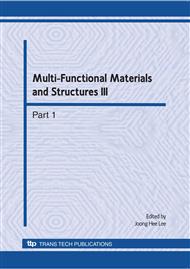p.1019
p.1023
p.1027
p.1031
p.1035
p.1039
p.1043
p.1047
p.1051
Effect of Phosphate and Nitrate Electrolytes on Growth of Ceramic Coatings on 2021 Al Alloys Prepared by Electrolytic Plasma Processing
Abstract:
2021 series aluminum alloy is used as the matrix material for its wide application in engineering to make AlON coating layers by the electrolytic plasma processing (EPP) method. The experiments were carried out on 2021 Al alloys in alkaline electrolytes which are eco-friendly and low-cost. The experimental electrolyte composition includes: 2g/L NaOH as the electrolytic conductive agent, 6~14g/L Na3PO4 as alumina formative agent, 0.5g/L NaNO3 as a nitrogen inducing agent. The effects of phosphate content variation are evaluated by a combined composition and structure analysis of the coating layer using with Philips-X’Pert X-ray diffractometer, JSM 5610 scanning electron microscopy for the specimens EPP-treated at room temperature in 10 min under a hybrid voltage (260V DC + 200V AC-50Hz). In addition, microhardness of the ceramic coatings was measured to correlate the evolution of microstructure and resulting mechanical properties. The wear tests show that a composite of AlON-Al2O3 high anti-abrasive coating formed as a result of a reactive process between Al in the alloy itself and O-N supplied by the electrolyte.
Info:
Periodical:
Pages:
1035-1038
Citation:
Online since:
August 2010
Authors:
Price:
Сopyright:
© 2010 Trans Tech Publications Ltd. All Rights Reserved
Share:
Citation:


